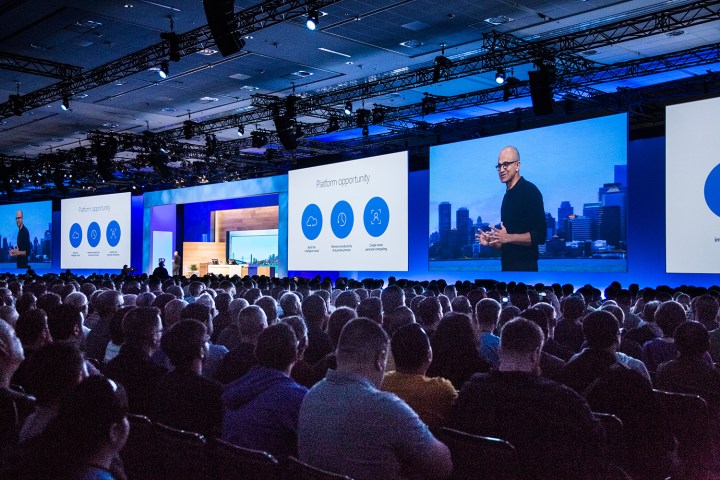
Windows 10 Anniversary Update

A year out since its initial launch, Windows 10 is about to get a big update. The first half of this year’s Build keynote was focused on the upcoming update and the numerous features and changes coming to the OS. Windows 10 biometric authentication is expanding to websites and apps. During the keynote, presenter Bryan Roper demonstrated logging in to the USAA Insurance website in the Edge browser using his finger print.
Roper also spent a considerable chunk of his presentation to show off the new pen and ink integration in Windows 10 apps. Roper explained that “72 percent of all users still use pen and paper daily,” and Microsoft wants to emulate that use through various apps including Word, Power Point, Sticky Notes, and Maps. The update will roll out this summer, while Windows Insiders will have access to it soon.
New and upgraded tools for developers

It wouldn’t be a Build keynote without some discussion on code. This is a developer conference, after all. Kevin Gallo took the stage to discuss a number of innovations developers will have access to in the Windows 10 Anniversary update, including visual studio update 2, and an anniversary SDK with new bells and whistles. Other notable inclusions with the Windows 10 update is Bash Shell, and a desktop app converter for Win32 and .Net apps, making it easier for developers to put their apps on the Windows App Store.
Bridging Xbox and Windows gaming

Phil Spencer, CEO for Xbox, gave a detailed presentation on how Microsoft is melding the two branches of their gaming division: Xbox One and Windows. All first-party Microsoft games can now release simultaneously on both Xbox One and Windows 10, provided the developers choose to, thanks to easy conversion tools and a unified App store coming with Windows 10 Anniversary update. DirectX 12 features, such as enhanced GPU efficiency, were also detailed. Spencer assured PC gamers that Windows App Store games will include support for mods and overlays, as well as G-Sync and Free sync, and showed off Windows 10 integration with Steam and Steam Workshop coming in the Anniversary Update. The new Windows App Store will also be a single unified store across all devices, including PC, mobile, and Xbox One.
Finally, Spencer announced that the Xbox One dev kit mode — a feature that was first announced with the Xbox One’s initial reveal — will now be available to all Xbox One owners. A demo showed off how quick and seamless it will be to transition from Dev mode and back on the console.
Hololens ships to developers

The first HoloLens, Microsoft’s augmented reality headset, is shipping to enterprise partners and developers right now. In order to give these developers a tutorial into creating for the HoloLens, Microsoft is releasing the source code for its Galaxy Explorer app, which allows users to wander and explore the cosmos just by walking around the room. Microsoft showed off how NASA is using the headset to give engineers better control over spacecraft modelling, and even explore the landscape of Mars. Similarly, an on-stage presentation showed how augmented reality through the HoloLens can give medical students better visual and hands-on learning experiences by displaying 3D models for them to view and analyze.
Cortana, Skype, and artificial intelligence

The second half of the keynote focused on Microsoft’s vision for artificial intelligence. Sataya Nadella once again took the stage, discussing broad concepts about man would work with machine, not against it, and artificial intelligence that combined the compassion of the human mind with the speed and proficiency of computing. Cortana, remote presence via Hololens, social bots, and Skype translate were listed as various examples of how Microsoft is making that vision a reality.
Cortana was the main example for many of these presentations. Marcus Ash showed off Cortana’s integration with various Windows 10 apps, such as Outlook, and how well she could understand commands. Similarly, Lilian Rincon gave a demo of how Skype will interact with Cortana, and how the pair enables users to do things such as order food and manage travel plans.
AI developer tools

Microsoft closed out its Build keynote by announcing several tools available for developers, including the Skype bot SDK, Cortana Intelligence Suite bot framework, and 22 artificial intelligence APIs. These APIs utilize years of machine learning for developers to take advantage of. The keynote concluded with a video on Saqib Shaikh, a blind software engineer who created his own bot to aid visually-impaired users identify their surroundings and interact with others, as an example of the kind of creations Microsoft’s AI tools enable.


